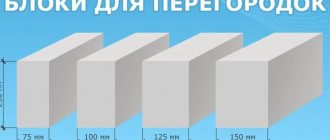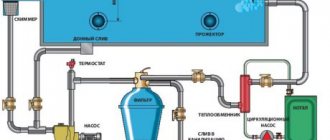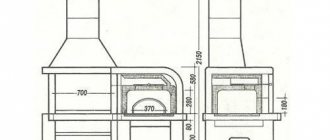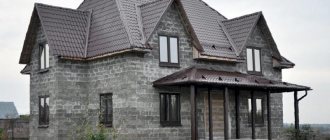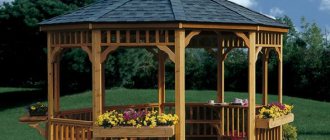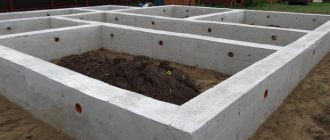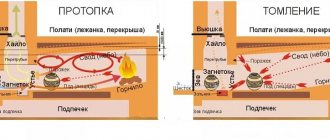Block production process
Vibrating machine for block production.
Composition of concrete mortar for such blocks (in parts):
- slag (preferably blast furnace, without ash and coal) – 14 parts;
- coarse sand (expanded clay) – 4 parts;
- gravel with granule size 5-15 mm – 4 parts;
- cement (M400-M500) – 3 parts;
- water – 3-6 parts.
Slag, coal combustion waste, brick waste, expanded clay, perlite, crushed stone, sawdust, etc. can be used as filler.
It is important to monitor the water content in the mixture. The solution should crumble when falling to the ground, but when squeezed in a fist, it should come back together
First, the dry ingredients are mixed, and only then water is added to them.
The sequence of operations when making blocks on a vibrating machine:
- a solution with a slide is placed in the mold;
- the vibrator is turned on for 3-5 seconds, the solution settles;
- if there is not enough solution, add it, insert the punch (clamp) and turn on the vibrator again;
- molding is completed when the clamp sits on the stops;
- turn on the vibrator for another 5-10 seconds and remove the form while the vibrator is still running.
The blocks should dry within 5-7 days, but it takes about a month to completely harden.
How to do it yourself
Knowing the dimensions of the desired block, we proceed to manufacturing the matrix:
- Blanks are cut from sheet metal with a thickness of 3–5 mm.
- To make voids in a block, you will need a void former, which can be made from pipes of the required diameter. It is advisable to use tapered pipes to facilitate removal from the finished block. At your discretion, you can use not only pipes, but also rectangular void formers, the main thing is not to forget to make them cone-shaped.
- We connect the workpieces using tacks, since a continuous seam can lead to metal leaking.
Note! Seams are made only on the outside of the mold, otherwise the block will not have the correct geometric shape.
Please note that all welding irregularities remain on the outside
- The height of the form should be 5 cm higher than the dimensions of the finished block. This is due to the fact that during vibration the mixture tends to be compacted, and also for installation on top of a pressure sheet.
- The next stage is the frame. To make it easier to move the machine, the base is placed on wheels, which allows you to move the machine without disturbing the finished block. It is recommended to make the racks on which the form will walk a little longer, so to speak with a margin, because you will always have time to cut it off - for convenience. All mechanisms and parts are made according to individual preference, and based on your height.
- Block making machine
- Bathhouse projects with a swimming pool under one roof
Stages of work
Advice! Don’t forget about the simple principle: the larger the shoulder, the less the effort. You can verify this by studying the diagrams of machines for pouring cinder blocks.
Step-by-step manufacturing sequence: 1-2-3 – binding of the base and connection of all mold elements, 4-5 – installation of void formers, 6-7 – connection to the frame, 8 – finished machine
All that remains is a small matter: connecting the electric motor to the network and bringing the power switch to a place convenient for you, and, of course, making test material.
Connecting electrical wires, if you are not an electrician, is better to entrust to professionals
Equipment for the production of cinder block
How to make a wooden barrel with your own hands - step-by-step instructions and drawings
Producing cinder blocks using special equipment will not be difficult. The casting process on a machine for the production of cinder blocks occurs as follows:
- A working mixture is prepared, consisting of cement, water and fillers. The latter must be passed through a sieve, removing large ingredients. Water should not completely fill the solution; the filler stays dry on the floor. The consistency is chosen independently, depending on the type of production.
- The mixture is loaded into the mold, compacted with packing or a special cinder block press. During the process, it is necessary to monitor the amount of the mixture; when compacted, it contracts.
- After which, the prepared block is removed from the mold.
Automatic production of cinder blocks
The drying process occurs under natural conditions, after 24 hours it is possible to move the finished material to the warehouse. Use in construction is available within a week after production, complete hardening occurs within a month. Special additives allow you to speed up the hardening process; maximum humidity and direct sunlight allow the cinder block to harden faster.
There are many designs, equipment, and machines for the production of cinder blocks. It is possible to make a machine yourself using the following elements:
- prepared cinder block matrix for molding the solution;
- necessary materials and tools;
- ventilated room with a leveled floor.
There are many types of machine designs available for do-it-yourself manufacturing, the drawings of which are available on the Internet
It is important to calculate the required production volumes before manufacturing; for your own needs it is enough to produce simple equipment
A small volume is produced by a hand-made matrix. The material can be any available - from hardwood to sheet metal. This process requires manual compaction of the material. Cinder block machines have a modification with a vibration motor, which will significantly save labor costs during production and speed up the process. The included electric motor with a vibration design for a few seconds allows you to fill the volume into the molds, adding filler in time.
In order to make a product not only for your own needs, you will need a full-fledged cinder block machine. The design will require the following tools in your arsenal:
- angle grinder;
- welding machine;
- marking tool.
According to the drawings, the structure is welded and processed with a grinder. The machine device for making cinder blocks may contain a vibration motor attached at the bottom. For convenience, the control panel and clamping mechanism are displayed.
Machine form
The prepared mixture is poured into the mold. A self-made cinder block machine requires a correctly marked form when pouring; the open cavity of the finished product consists of 30% of the area. Mold materials:
- metal corner;
- steel sheet 5 mm;
- pipes with a diameter of 8 cm.
Shapes of cinder block machine
The mold frame is prepared from sheet metal, markings are made in accordance with the double size of the part. Pipes are installed on the hanging plates to fill the technological voids of the blocks, and the edges of the machine are closed. The role of the plates is in the form of a limiter, which acts during operation of the vibration device. The lid is made to fit a mold with holes, the diameter of which should be slightly larger than the pipes themselves. Handles installed on different sides serve to raise and lower the mechanism.
Types of equipment
When opening a workshop for the production of cinder blocks, you will need:
- concrete mixer;
- vibrating sieve;
- wheelbarrow;
- racks;
- cinder block machine.
There are several types of machines on the market:
- mechanical with manual control;
- semi-automatic;
- fully automatic lines.
They can also be divided into three categories:
- portable;
- mobile;
- stationary.
Portable – mechanical machines with manual control. As a rule, in one cycle it is possible to produce 1 cinder block or 2 half-blocks. They are characterized by mobility, simplicity, low weight and cost:
- Block Master 2 (BM-2) is a portable machine with a productivity of 40 pieces/hour and a power of 0.25 kW. The cost of such a machine is from 8200 rubles.
- Presser 1 mini No. 2 – machine for 1 block, equipped with a 170 W vibrator with a pressure frame. Costing from 6340.75 rub.
Mobile semi-automatic machines are distinguished by the presence of a matrix of several blocks and more powerful vibrators. When purchasing these units, it is necessary to take into account the availability of a flat area for the production of blocks. The cost of such equipment will be slightly higher:
- The SSh-1 V, SSh-2, SSh-3 units have a similar operating principle, are equipped with a 2-block matrix, with motors with a power of 300 W or more. They have a productivity of 40-90 pieces/hour, and may also have an additional vibrator included. The cost of such units starts from 13,600 rubles.
- Cinder block machines of the Comanche series allow the production of 2-4 modules per cycle. Depending on the model, they have a productivity of 60-120 pieces/hour and a power of 0.25-0.48 kW. The price varies from 25,000 rubles. up to 49,000 rub.
There are also such models as: Mars, Tornado, Layer, Dragon, etc. They have the same operating principle and differ in the number of blocks produced per cycle, power and type of void formers in hollow cinder blocks.
Stationary equipment is much more expensive and more labor-intensive to maintain. One of the disadvantages is the need to remove finished products, several pieces on a pallet at once. Such units can be either mechanically controlled - brick making presses, or automated - cinder block mini-factories.
Equipment for cinder blocks
Vibropress machines for the production of cinder blocks and sand blocks with manual loading of concrete mixture. The blocks are formed onto technological replaceable wooden pallets. The power of such equipment is 8.5 kW, productivity is 20-30 cycles per hour, 4-5 blocks are produced per cycle. The cost of such a mechanism starts from 300,000 rubles.
The cinder block mini-plant DMYF-10A is equipped with hydraulic steering and automatic moving method. The power of this equipment is 16 kW, productivity is 1300-1400 pcs./hour. You can purchase such a plant for 750,000 rubles.
Forming methods
Do-it-yourself bathhouse made of expanded clay concrete blocks: step-by-step instructions and the best projects with 52 photos and 2 videos
Factory molds for preparing cinder blocks are made of reinforced concrete or steel. Such parts can easily withstand the weight of a large volume of solution. As for do-it-yourself molds, they are most often made of wood or steel sheets. Such elements largely play the role of special formwork.
To save on raw materials and free time, molds are mainly assembled without a bottom. You can put a simple film under them. Thanks to this method, the entire process of block formation can be significantly simplified. It must be remembered that the forms themselves must be made of perfectly smooth wood parts. The working surface will be a concrete base, a table with a flat and smooth tabletop, or a sheet of iron, which also does not have any defects.
Let's take a closer look at how to make a mold for slag blocks:
- you need to choose sanded boards 14 cm long (the width should be a multiple of this parameter);
- then, using a hacksaw, you need to separate the segments, which will then play the role of transverse partitions;
- then you will need to connect the segments with longitudinal elements to form a rectangular frame;
- Next, you need to cut a sheet of steel or any other material with a smooth surface into separate plates measuring 14x30 cm;
- in the inner part of the resulting structure, cuts are made that will act as grooves, the width of which is equal to the dimensions of the dividing strips;
- then the sections responsible for the separation are fixed in cuts, creating a mold for the production of 3 or more slag blocks.
In order for the resulting container for hardening the solution to serve as long as possible, at the final stage it is recommended to coat both metal and wood structures with oil-based paint. This form is suitable for preparing cinder blocks, the dimensions of which are 14x14x30 cm.
Making cinder blocks
In domestic construction, two methods of producing cinder blocks are practiced - using homemade wooden matrices or special equipment. Of course, you can buy cinder block molds, but if you can easily make them yourself, why spend the extra money?
Wooden forms
In general, molds for cinder blocks can be made not only from wood, but also from metal (galvanized sheets or other material). However, since wood is the cheapest and most common material, we will focus on it.
Since the standard size of a cinder block is 40x20x20 cm, the shape must have the appropriate parameters. The cell into which the solution will be poured consists of a bottom and walls. To save material and your own time, you can make a large mold with a single frame, separated by crossbars that form cells of the required size. The width should not exceed 2 m, otherwise it will turn out to be too bulky and inconvenient. The price of molds for cinder blocks in construction stores is often unreasonably high, especially when you consider how easy it is to make it yourself from scrap materials.
The cross members can be made of wood, like the frame itself, but it is better to combine wood and metal. For example, the frame is made of moisture-resistant plywood, and the walls of the cells are made of sheet metal cut into strips. By the way, the form does not have a bottom, so the intermediate elements should be fastened together using cuts, joining each other. Make formwork without a bottom and cut the boards so that it is possible to insert transverse elements into longitudinal ones and fix everything with a single frame (frame). You will get a collapsible structure from which it is easy to remove finished blocks.
The structure is laid on a clean, flat surface covered with plastic film or cellophane. The boards are painted with oil paint so that the solution does not stick to them, and the blocks easily move away from the mold before the mixture hardens.
All that remains is to fill the form with the prepared solution and compact it well. To make a hollow block, glass bottles are inserted into the solution upside down, excess solution is removed and the surface of the block is leveled. After 5-6 hours, the bottles are removed, and voids remain in their place. The blocks are dried for 24 hours, after which they are removed from the mold and stored in stacks.
Machine form
How to make cinder blocks with your own hands
Machines for making cinder blocks vary in design complexity.
This can be a collapsible device made of wood or metal. It has different sizes depending on the number of blocks that will be produced at the same time. This design can be made with your own hands; bottles of the required diameter filled with water are used to produce voids. In this case, a vibropress is not used.
Another option is a vibrating machine, which consists of a mold located on a table or a special stand. This device is equipped with a motor and can be equipped with a lifting mechanism for removing finished products from the mold.
Wood or metal structures are used as a mold for making cinder blocks. The standard size is 390×190×190 mm, but you can choose the dimensions at your discretion.
Since slight shrinkage will occur during pressing, it is necessary that the height of the mold exceeds the height of the block being produced by 5 mm.
What are blanks?
Since cinder block material varies in size and appearance , there is no single template from which standard products can be produced. Therefore, in the production of slag concrete, special collapsible containers are used, consisting of 4 walls, a bottom (in some types of blanks a bottom is not provided) and matrices (one or several replaceable ones, depending on the size and size).
The number of matrices depends on the volume of products that need to be produced in 1 day. Matrices can be made of wood or metal.
Types of designs
Blanks for the production of cinder blocks are divided according to the material from which they are made and the number of voids in the future product. For the first category, you can write the following. They are:
- Plastic.
- Wooden.
- Metal.
Plastic
Plastic blanks for cinder block products on an industrial scale are not particularly popular. They will not be able to withstand constant pouring over a long period of time . This greatly limits their scope of application. Therefore, only a few manufacturers produce for sale plastic containers for pouring slag concrete.
The plastic structure comes in only one size – 390x190x188 mm.
But the advantage of such structures is that they are light in weight and easy to operate , because the walls of the workpiece do not need to be lubricated each time with used machine oil or a special self-destructive lubricant. In addition, their price is much cheaper than the same products made of metal or wood.
Wooden
Wooden structures are a rectangular box made of laminated plywood. They can be used both in production for the manufacture of large volumes of products, and for home production of cinder blocks.
To give the walls greater rigidity, clamps are used that tighten all 4 walls . And so that the cinder block solution does not destroy the structure from the inside, the bottom and walls are covered with polyethylene.
The advantages of containers made of wood are their average, affordable price (lower than those made of metal), light weight, making the workpieces easy to move around the site and lift, as well as the number of fills - on average 50 times.
But there is also a minus - the material is sensitive to moisture , so pouring the solution into wooden forms should only be done in the fresh air, in dry weather, and the filled forms should be stored in a well-ventilated, not damp area.
Metal
Metal forms come with or without a bottom. And the presence of a bottom divides metal products into solid and collapsible. If there is no bottom in the mold, then the walls of the product do not have sufficient rigidity, so in industrial production they mainly use blanks with a bottom 6 mm thick.
The bottom can be further strengthened with channels, and special metal inserts can also be used, which will allow the production of cinder blocks with a tongue-and-groove system (for partition slabs).
The most popular metal forms are made into 35, 63 or 70 blocks of standard sizes 390x190x188 mm .
Features of the material
Cinder block is a building material that has proven itself to be one of the most durable and unpretentious. It has considerable dimensions, especially if you place an ordinary brick next to it. You can make slag blocks not only in a factory setting. Some craftsmen undertake this work at home. If you strictly adhere to the technology, you get high-quality and strong blocks from which you can build a house or any outbuilding.
If a decision has been made to independently produce such products, then a number of its features should be taken into account.
- Cinder block is a fireproof material. It does not ignite itself, and does not intensify an existing flame.
- Really good quality blocks make long-lasting and sustainable homes/outbuildings. Such buildings will not be harmed by harsh climatic conditions, hurricanes, or constant gusty winds.
- Repairing cinder block buildings does not require extra effort and free time - all work can be completed in a short time.
- Cinder blocks are also distinguished by their large sizes, thanks to which buildings made from them can be erected very quickly, which pleases many builders.
- This material is durable. Buildings built from it can stand for more than 100 years without losing their previous characteristics.
- Another feature of cinder block is its soundproofing component. Thus, in dwellings made from this material there are no annoying street noises.
- The production of cinder blocks is carried out using various raw materials, so it is possible to select the optimal products for any conditions.
- What distinguishes cinder block is that it is not subject to attacks by various kinds of parasites or rodents. In addition, it does not rot, so it does not have to be coated with antiseptic solutions and other similar compounds designed to protect the base.
- Despite their decent dimensions, such blocks are light in weight. This feature is noted by many masters. Due to their lightness, these materials can be easily moved from one place to another without calling a crane. However, it must be taken into account that some types of such products are still quite heavy.
- Cinder block is not afraid of low temperatures.
- These blocks are distinguished by their high heat capacity, thanks to which they make cozy and warm homes.
- Temperature fluctuations do not harm the cinder block.
Cinder block buildings are usually decorated with decorative materials to give a more aesthetic appearance.
However, it is very important to remember that the cinder block cannot be covered with ordinary plaster (any “wet” work with this material should not be carried out). You can also use a special decorative block, which is often used instead of expensive cladding. When working with cinder block, it is important to take into account one important feature - this material is characterized by high water absorption, so it must be protected from contact with moisture and dampness
Otherwise, the blocks may collapse over time. Unfortunately, the geometry of the slag blocks leaves much to be desired. That is why, when laying floors from such material, you will have to constantly adjust individual elements - trim them and saw them. Cinder blocks have a relatively low cost.
Features of homemade machines
Types of equipment for the production of expanded clay concrete blocks:
- Manual vibration machines.
- Mobile mechanized machines.
- Vibrating tables.
- Vibrating presses.
Manual vibrating machines
Consist of an electric motor and a vibration stand. The mixture is placed into molds. The equipment allows you to produce solid or hollow blocks. Technical equipment has stationary or removable void formers.
The main advantage of the equipment is its small size and relatively low cost.
The disadvantage is low power and low productivity. All processes take place with the direct participation of humans. The equipment power does not exceed 2.0 kW.
Mobile mechanized machines
Equipped with vibration equipment for expanded clay concrete blocks with a power of 2 to 10 kW. Trailed or removable casters are used for movement. To perform additional functions they are equipped with modular systems.
The advantage is the ability to move freely, small dimensions, low cost.
The disadvantage is the low productivity and energy consumption of the equipment.
Vibrating tables
They are a spatial structure with an electric motor and a vibration device. The table surface consists of a steel tray. For its manufacture, galvanized steel sheet with a thickness of 3 mm with sides is used.
The molds filled with the mixture are placed on a pallet. Under the influence of vibration, the solution is compacted and takes the required shape. After this, the products are sent for drying.
The advantage of vibrating tables is their simplicity of design, maintenance, and minimal equipment cost.
The disadvantage is low productivity and a large proportion of manual labor.
Vibrating presses
Used in industrial enterprises. They have a power of up to 500 kW. Equipped with automation and non-destructive testing devices for finished products.
The equipment operates in automatic and semi-automatic mode at all stages of production. Productivity reaches 150 or more cubic meters of products per shift.
Choosing which machine to use for making cinder blocks
When deciding on a device, it is worth considering the following design options:
- a simplified device that makes it possible to produce block products at home;
- an improved unit, the design of which includes a mechanism for compacting and extracting finished products.
The choice of the optimal option is carried out depending on the need and availability of funds.
Simplified cinder block machine with your own hands - drawings and recommendations
If the need for material is small, there is no need to manufacture a complex unit equipped with a vibration motor and special mechanisms. A simplified method allows products to be manufactured in special molding boxes.
The technology involves performing the following work:
- Assembling molds and oiling the surface inside the box.
- Pouring cinder block mortar into collapsible containers.
- Leave for 5–6 hours until the composition sets.
- Disassembling the box and carefully removing it.
- Drying manufactured products under a canopy or indoors.
To build this kind of machine, you must have skills in working with a welding machine and metalworking tools.
The use of wooden or metal liners, as well as glass containers, allows you to produce hollow blocks. It is not difficult to make a simplified machine for cinder blocks with your own hands - it is a metal or wooden container, the size and shape of which correspond to the parameters of the product.
Vibropress in the production of cinder blocks
The brick press is a powerful tabletop, which is equipped with special springs
The brick press is a powerful tabletop, which is equipped with special springs. On an industrial scale, such equipment is always at hand, but at home it is not. In order to make a vibrating machine for the production of cinder blocks you will need:
- high-speed electric motor with two shafts, with a power of at least 0.5 kW;
- grinder and electric welding;
- iron sheet (thickness 3 mm);
- fittings (diameter 12 mm).
The vibration process will take no more than 15 seconds, then the vibration form is removed in a vertical position and within a day the finished blocks can be laid.
In essence, a brick press for cinder blocks is a regular tabletop equipped with springs. The vibration process occurs due to a shift of the center of gravity to the eccentric (see example of a brick making press in the photo)
Cinder concrete blocks - characteristics and purpose of the material
One of the reasons for the increased popularity of slag-filled concrete blocks is the low cost of the material. It is associated with the use of waste from metallurgical enterprises - slag - in the production process.
Along with traditional components, Portland cement and river sand, various aggregates are used:
- brick break;
- crushed stone screening;
- granite chips;
- various slags and ash;
- expanded clay particles.
The use of cinder blocks in construction allows you to reduce the cost of constructing walls several times
The manufacturing process is carried out in various ways:
- industrial method at specialized enterprises with processing of products in drying chambers;
- at home from available raw materials, using a self-assembled machine for making blocks.
Using homemade equipment you can produce various types of slag concrete products:
- full-bodied, with an increased margin of safety. They are used quite rarely, as they retain heat less well;
- hollow, characterized by high thermal insulation properties. To ensure strength, the volume of cavities should not exceed 1/3 of the total volume of the product.
The dimensions of the products are determined by the dimensions of the mold. When making products yourself, the size of the molding box can be any. However, many people prefer the standard dimensions of 19x18.8x39 cm.
The increased volume of the slag concrete block can significantly reduce the duration of various types of construction work:
- construction of capital walls;
- construction of internal partitions.
It is perfect for the construction of utility buildings, sheds, and storage buildings.
If you need to make a cinder block yourself, the machine allows you to quickly solve the problem. The resulting material has many advantages:
- high thermal insulation characteristics. Due to reduced thermal conductivity, the material prevents heat loss;
- increased dimensions and low weight. This makes it easy to transport products and quickly build walls from them;
- resistance to the development of microorganisms. This is achieved due to the properties of the slag included in the structure of the block;
- low price. A cinder block machine with your own hands allows you to make products that are cheaper than purchased blocks.
The material also has weaknesses:
- low durability. The period of operation of buildings made of slag concrete is up to three decades;
- reduced safety margin. The characteristics of the material allow the construction of buildings no more than two floors high;
- the appearance of cracks under the influence of shear forces. During shrinkage, cracking occurs along the cinder block mass.
To ensure an attractive appearance of buildings, the cinder block surface needs external cladding. These disadvantages do not stop developers who want to build a utility building or a small building in a limited time at low costs.
You can use homemade cinder blocks a month after they are made.
Expanded clay block production technology
The production of expanded clay blocks consists of the following stages:
- Preparation of the working mixture.
- Molding of products.
- Pre-hardening.
- Drying of products and strengthening.
- Transportation of expanded clay concrete blocks to the warehouse.
Preparation of the solution
To prepare 100 kg of working mixture, take the following proportions, kg:
Expanded clay - 54.5.
Sand – 27.2.
Cement – 9.21.
Water – 9.09.
Cement grades M400 or M500 are used in dry and pure form. To obtain a glossy surface, tile adhesive is added to the mixture. The plasticity and workability of the solution is increased with the help of plasticizers.
Chemical additives increase the frost resistance and water resistance of finished products. To increase porosity, wood saponified resin is used.
Concrete mortar is prepared by thoroughly mixing the mixture components. A weighed amount of ingredients is placed in a concrete mixer or special container. The composition is stirred for 2-3 minutes.
From the finished portion of the mixture, 9-10 standard blocks measuring 39x19x19 cm are obtained.
Product molding
The prepared composition is placed in special steel molds. After each use, the molds are rinsed with clean water and wiped with a dry cloth.
The molds with the mixture are installed on a vibration stand. Under the influence of vibration, the mixture in the molds is compacted. As sedimentation and compaction proceed, the required amount of solution is added. Excess concrete is promptly removed.
After sufficient compaction, the finished products are placed in the drying chamber.
Drying and storage
Drying is carried out at a temperature of 50-60°C for 2 days. After the specified period, the products are dried for 25-26 days in an open warehouse under natural conditions. The dried products are sent to the finished product warehouse for subsequent sale.
How to make a vibrating machine for cinder blocks with your own hands
Many people wonder whether a cinder block production machine should be vibrating. Here we can safely answer that, yes, the presence of a vibrating machine will allow us to make cinder blocks of the best quality, without voids inside. The drawing of a vibrating machine for cinder blocks in itself is not too difficult to master, and the main elements of a vibrating machine are:
Matrices for pouring the solution, which are mounted on top of the vibration installation. To make a matrix for a cinder block, you will need to take a steel sheet with a thickness of at least 0.2 mm. The metal sheet is cut into rectangles having the following dimensions: 390x190 mm. Their number is determined individually, depending on exactly how many cinder block matrices need to be made.
Typically, no more than three matrices are installed on one block vibrating machine. After welding the cut pieces of metal, it remains to provide voids inside the future matrices. For this purpose, you need to take a metal pipe 90 mm in diameter, and then cut it into 9 pieces, 190 mm long. To weld pipes to each other, a metal strip should be used.
At the next stage of manufacturing a vibrating machine for cinder blocks, you assemble the press yourself. There is no point in refusing to manufacture it, since using a press for a vibrating machine, it will be possible to exert the necessary pressure on the mixture poured into the matrix. To make a press for a vibrating machine, you will need to cut a rectangle out of metal exactly to the dimensions: 385x185 mm. Then, in the same way as the pipes are installed in the matrix, three even holes will need to be cut in a piece of metal.
Vibrating table assembly
The third stage in the manufacture of a vibrating machine for cinder blocks includes assembling the vibrating table. Here you can go in two ways: make a vibrating table, with eccentrics on the axes and a subframe, or significantly reduce the cost of the entire structure.
In this case, directly to the side of the tabletop, which would accommodate three matrices, you should screw fasteners for an electric motor with a power of at least 0.5 kW. Then a nut with an eccentric is attached to the motor shaft, which will create the necessary vibration while the motor is running.
It is very important to use a closed-type electric motor when manufacturing a vibration machine. If nothing else is at hand, then you should provide a special apron from a piece of metal that would completely cover the engine and prevent water and solution from getting inside it
The final stage in the manufacture of a vibrating machine is the installation of the table top with the motor on the supports. To do this, you will need to weld a frame from a metal corner; at the bottom of it, if desired, you can easily attach wheels if you need to have a mobile vibrating machine for cinder blocks on hand.
Making a vibrating table
You can find paid machine drawings on the Internet, but don’t waste your money. It’s not at all difficult to make drawings of a machine for producing cinder blocks with your own hands, based on those photographs and materials that are distributed on the Internet for free.
A vibrating machine will allow you to produce cinder blocks much faster, since you won’t have to wait a day for the solution to dry. You can use a sheet of metal as a tabletop. You will also need springs, for example, motorcycle springs.
The motor must be attached in the middle of the tabletop. It can be used from an old washing machine. A pulley with an eccentric is installed on the motor shaft, which will provide vibration to the motor and along with it the entire platform, attached at the corners with springs on top of the tabletop.
Thus, you will make a vibrating table for a cinder block with your own hands - the most difficult part of the machine. All other details and improvements can be customized during operation. For example, wheels can be attached to the frame structure so that the machine can be moved conveniently.
Advice! A washer with a displaced center of gravity is suitable as an eccentric. You can also weld a perpendicular bolt with nuts to the shaft.
Homemade vibrating machine
Types and advantages of cinder blocks
Cinder blocks are a popular type of building materials that are created by hardening a concrete mixture in a special form or using vibration pressing technology. The name itself comes from the name of the filler, which can be used as ordinary furnace or blast furnace slag.
As construction technologies developed, the range of fillers used expanded greatly, although the previous name remained unchanged. The choice of filler determines the performance properties and cost of the product. Currently, monolithic or hollow cinder blocks are offered for sale. Representatives of the first group are characterized by increased strength, but are much cheaper than monolithic models. Most often they are used when arranging foundations.
The concrete mixture used to create blocks may include ash, slag and a number of other waste products from coal combustion. To make high-quality material at home, you can take fillers such as waste bricks, sawdust, expanded clay, perlite, gravel and others.
By the way, cinder blocks do not necessarily contain slag. Fillers can be very different, but the name remains the same.
The key advantages of slag concrete blocks include the following:
- Excellent heat and sound insulation of walls.
- Low cost - cinder blocks are much cheaper than traditional bricks, foam blocks or any other building material.
- Simplicity of installation and ease of further use.
- No difficulty in making it yourself. You can create a set of good building material with your own hands. This opens up wide opportunities for private developers to erect a wide variety of buildings without using the services of masons. (by the way, one block can replace 3-5 bricks).
Types of cinder blocks
There are two types of building blocks:
- Solid cinder blocks are used for the construction of foundations, load-bearing partitions and walls.
- Hollow ones are much lighter, so they do not create a load on the foundation. In addition, they have good heat and sound insulation. Due to these characteristics, hollow blocks are used to build walls.
The very first building blocks were made from slag and a binding material in the form of cement. are obtained from concrete mortar using vibrocompression . In addition to slag, their composition may include:
- granite crushed stone;
- granite screening;
- volcanic ash;
- fight of concrete and brick;
- sand;
- river gravel, crushed stone;
- expanded clay;
- broken glass;
- cement;
- broken hardened cement;
- battle of concrete and brick.
Do-it-yourself production of building blocks can be done using a vibratory pressing machine or wooden molds .
Mixture composition
The production of slag blocks at home obliges the craftsman to adhere to a specific composition, as well as certain proportions of all components. Thus, the binding ingredient in this material is usually cement of a grade not lower than M400. As for the filling component, it can consist entirely of slag or be mixed. The last option is obtained by adding a small amount of crushed stone, sand (simple or expanded clay), crushed brick and fine expanded clay.
When making cinder blocks, the following proportions must be observed:
- 8-9 parts of the filling component;
- 1.5-2 parts of astringent ingredient.
For example, out of 9 parts, at least 6 are accounted for by this component, and the rest is made up of crushed stone and sand. In theory, when making it yourself, it is permissible to use concrete or brick scraps, screenings.
The standard proportions of cinder block are:
- 2 parts sand;
- 2 parts crushed stone;
- 7 parts slag;
- 2 parts of Portland cement marked M400.
As for water, it is customary to add it in an approximate ratio of 0.5 parts. The result is a semi-dry solution. To ensure its high quality, you need to take a small handful and throw it on a hard surface. If the thrown lump crumbled, but under compression conditions regained its previous shape, then the composition can be considered suitable for further use.
If you plan to obtain colored cinder blocks, then the recipe is supplemented with colored chalk or brick chips. To increase the strength characteristics of this material, special plasticizers are used. In some cases, they resort to adding gypsum, ash or sawdust.
Drying
Drying is another important step in the production of slag blocks. The production process itself usually takes about 2-4 days. Sufficient strength characteristics that allow you to proceed to the use of blocks are usually achieved after 28 days. This is exactly the amount of time needed to obtain high-quality building material suitable for carrying out certain works. Cinder blocks can also dry naturally. Typically, this process takes place using a simple method of producing materials (in conventional forms).
To dry cinder blocks, special chambers are often used to prevent cracking during the hardening process. To prevent the blocks from becoming cracked, they must be moistened from time to time. This process is especially relevant if the production process is carried out in hot weather.
Homemade product
In addition to what we described earlier, you can make a homemade machine for cinder blocks, only this will require experience in welding and “friendship” with connecting the device to the network.
It cannot be said that this process (even taking into account your experience, if any) can be called easy, but we will still try to help:
- First , find a drawing of a cinder block machine on the Internet.
- Secondly , purchase all the materials, mainly metal sheets, metal tubes and wires. Don’t forget about the vibrator motor, which is freely sold in stores.
- Thirdly , decide on the size of future blocks.
For the work you will need a welding machine, an electric grinder and metal scissors, and, of course, instructions for use.
Basic requirements for cinder block production
Standard product dimensions are 180*90*390 mm, each block usually has 3 holes
The standard dimensions of the product are 180*90*390 mm, each block usually has 3 holes. The production technology involves the use of M400 type cement mortar, as well as the addition of the required proportion of blast furnace slag and sand. Cinder block production involves hand-making and the use of a cinder block machine. It is worth noting that one bag of cement mixture allows you to make about 36 blocks. The product must be in perfect shape, otherwise small irregularities or deviations can lead to poor wall laying. To obtain the correct geometry, the cinder block mold is filled to the end with a small slide; during vibration, the solution will shrink and lie flat. The solution is prepared in the following proportion:
- 7 parts slag;
- 2 parts sand;
- 1, cement parts;
- no more than 3 parts water.
Additional components you can add are ash, broken brick, sawdust or gypsum. But to increase the moisture resistance and strength of the product, you can add a plasticizer (see example in the photo), only 5 grams is enough.
If you are planning to make building material yourself, it is important to know that it is better to carry out the production process in a room where the resulting material can be properly dried. It is advisable to choose a location for the production of cinder blocks close to sand quarries or cement plants.
It is advisable to choose a location for the production of cinder blocks close to sand quarries or cement plants.
Manufacturers, characteristics and cost of industrial equipment
The most popular among specialists are the developments of domestic manufacturers. The Russian market offers a wide range of machines for the production of expanded clay concrete blocks. The most famous of them are presented in the table.
| Name of equipment | Main technical characteristics | Manufacturer | Cost, rub. |
| Cinder block machine "Siberia" | Weight, kg - 12.4 Dimensions, m - 0.45?0.38?0.33 Installation power, kW - 0.12 Output, block/shift – 320 Block size, cm - 39?19?19 | LLC “Delay-bloki.ru” Russia, Moscow | 6 800 |
| Vibration pressing machine SPRUT-2 | Weight, kg - 140 Installation power, kW - 0.55 Output, block/shift - from 600 to 1500 Block size, cm - 39?19?19 | Prommash LLC Belgorod region, Starooskolsky district, Neznamovo village | 65 000 |
| Automated vibration-pressor complex Condor 1—90—TB | Weight, kg - 1570 Dimensions, m - 1.2x1.8x2.8 Installation power, kW - 16.5 Output: — 750 block/shift (39x19x19 cm); — 1800 bricks (25x12x88 cm); - 50 m2 of paving slabs (50?50 cm). | Stroytekhnika LLC Russia, Zlatoust city, Krasnaya Gorka village | 520 000 |
| Automated vibration-pressor complex "Rifey-Udar" | Weight, kg - 4400 Dimensions, m – 6.4x4.9x2.6 Power, kW - 21.6 Performance: — 1700 block/shift (39x19x19 cm); — 4000 bricks (25x12x88 cm); — 100 m2 of paving slabs (50×50 cm). | Stroytekhnika LLC Russia, Zlatoust city, Krasnaya Gorka village | 1 515 000 |
